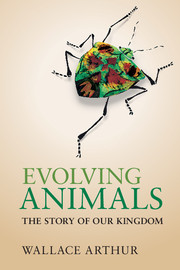Book contents
- Frontmatter
- Dedication
- Contents
- Preface
- Acknowledgements
- 1 What is an animal?
- 2 Before there were animals
- 3 How to make a fossil
- 4 The Cambrian explosion
- 5 How to make a species
- 6 Jellyfish and their kin
- 7 How to make a tree
- 8 The enigmatic urbilaterian
- 9 Animal symmetry and heads
- 10 A plethora of worms
- 11 Trends in animal complexity
- 12 Where the octopus is king
- 13 How to make an animal
- 14 Exoskeletons galore
- 15 Extinction
- 16 Mouth first, mouth second
- 17 Comparing embryos
- 18 Larvae, mouthparts and moulting
- 19 The animal toolkit
- 20 Vertebrate origins and evolution
- 21 From water to land to water
- 22 Variation and inheritance
- 23 Evolutionary novelties
- 24 Human origins and evolution
- 25 Animal plasticity
- 26 The nature of adaptation
- 27 The direction of evolution
- 28 Animal extremophiles
- 29 Extraterrestrial animals?
- 30 The ghost in the machine
- Appendix
- References
- Index
18 - Larvae, mouthparts and moulting
Published online by Cambridge University Press: 05 August 2014
- Frontmatter
- Dedication
- Contents
- Preface
- Acknowledgements
- 1 What is an animal?
- 2 Before there were animals
- 3 How to make a fossil
- 4 The Cambrian explosion
- 5 How to make a species
- 6 Jellyfish and their kin
- 7 How to make a tree
- 8 The enigmatic urbilaterian
- 9 Animal symmetry and heads
- 10 A plethora of worms
- 11 Trends in animal complexity
- 12 Where the octopus is king
- 13 How to make an animal
- 14 Exoskeletons galore
- 15 Extinction
- 16 Mouth first, mouth second
- 17 Comparing embryos
- 18 Larvae, mouthparts and moulting
- 19 The animal toolkit
- 20 Vertebrate origins and evolution
- 21 From water to land to water
- 22 Variation and inheritance
- 23 Evolutionary novelties
- 24 Human origins and evolution
- 25 Animal plasticity
- 26 The nature of adaptation
- 27 The direction of evolution
- 28 Animal extremophiles
- 29 Extraterrestrial animals?
- 30 The ghost in the machine
- Appendix
- References
- Index
Summary
In the previous chapter we dwelt largely on vertebrates. The embryos shown to illustrate patterns such as von Baerian divergence or the developmental egg-timer all belonged to one vertebrate group or another. Also, when discussing the complications to such patterns provided by indirect development and larvae, the larvae we examined were those of our reasonably close relatives – the echinoderms or spiny-skins, and specifically sea urchins. What this means is that the examples that came into focus in Chapter 17 were all from the mouth-second super-group of animals, the deuterostomes.
In this chapter we will make good our omission from the previous one of the complementary group of animals, the protostomes. This super-group in fact includes the bulk of the animal kingdom, both in terms of number of phyla – it has about 20 of the animal kingdom’s 35 or so phyla – and (because the arthropods are included here) the largest aggregate number of species. Given its size, we need to probe a bit into its internal structure, in the sense of the evolutionary relationships among its constituent phyla. But, as ever in this book, we need to do this without introducing a whole new raft of technical terms. This is a difficult challenge but hopefully not an insurmountable one.
- Type
- Chapter
- Information
- Evolving AnimalsThe Story of our Kingdom, pp. 177 - 186Publisher: Cambridge University PressPrint publication year: 2014



